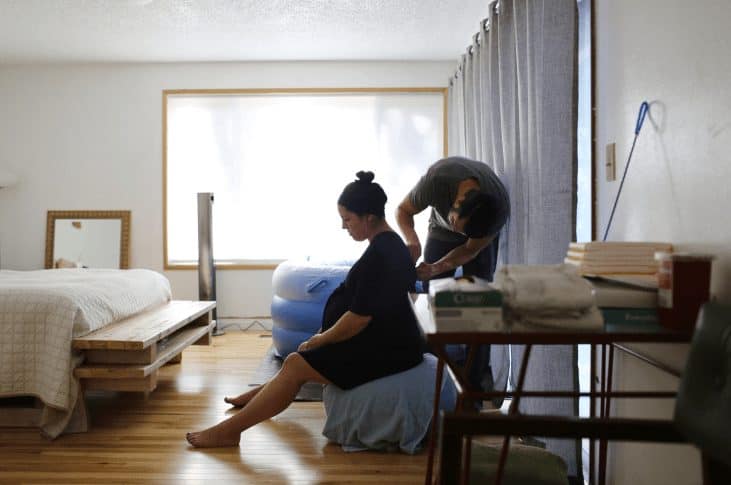I have some bad news for you, momma. Prenatal yoga is not going to miraculously give you the birth of your dreams all by itself.
What Has the Biggest Impact on Your Birth?
What many teachers might not tell you is that overwhelming evidence from experts shows that the two factors most likely to impact your birth outcomes are your provider and the place you deliver. For example, if you deliver with midwives at home, you are definitely not going to have certain interventions that are unavailable in that setting (except in an emergency, obviously, when you would be transferred to a hospital). To a lesser extent – but not as little as you might imagine – the processes and beliefs of the practitioners you work with will undoubtedly influence things. For example:
- Will you be allowed to go overdue, or will your doctor want to induce you?
- What does your provider believe about “big babies”?
- How long will your provider or hospital allow you to labor with ruptured membranes?
- Do the nurses expect to see a certain rate of cervical change?
- At what stage of labor do your doctor and hospital want you to come in?
- Do they encourage you to wait until you feel the urge to push?
- Do they encourage movement during labor?
- What pushing positions will they accommodate?
- How many of your type of birth (natural, etc.) do they see?
- What do they consider to be “high risk”?
All of these questions will have FAR more impact on your outcomes than anything you can control.
Sure, Sure, But Can Prenatal Yoga Help with Labor?
That said, perhaps you’ve arrived here, dear reader, too late to make any kind of changes to your birth team or having already made decisions you’re really excited about. In that case, you’re probably looking to find out what more you can do.
Let’s take a second to reflect on something. If you’re capable of giving yourself a “better” birth outcome, that would also mean you’re also capable of “screwing it up.” I don’t like that idea one bit. I reject the notion that everything that doesn’t go according to plan in a birth is someone’s fault, and certainly not all the mother’s. So, if we reject that things that go wrong are someone’s fault, then we also have to acknowledge that we can’t take credit if everything goes right.
I know, this isn’t the enthusiastic glowy, floaty, ra-ra post you were hoping to read. But I think this is important stuff to say. Nothing before, during, or after pregnancy is 100% in our control. That’s part of the ride, baby.
(And might I suggest prenatal yoga to help you manage the emotional turmoil that lack of control creates?)
So, cutting to the chase: Yes, there is some evidence that prenatal yoga can help improve birth outcomes, shorten the duration of labor, and might help reduce birth injuries like tearing. (That doesn’t mean it’s your fault if you have any of these things.) It does this in a few ways.
For Prenatal Fitness Classes that give you the best chance at an easier birth, check out the Thrive Prenatal Fitness Program
Prenatal Yoga to Improve Baby Position
Your pelvis is designed to be a lovely, symmetrical bowl for baby to rest in. However, when your soft tissue is tight or imbalanced, it can cause the pelvis to shift out of alignment or the uterus to sit funny in the pelvis. This could limit baby’s ability to wiggle around and get into an optimal position for labor.
By default, his or her big noggin drops to the bottom of the uterus, and the chin tucks to the chest, presenting the smallest part of the skull at the opening of the uterus. In this position, the work the uterus does in labor is more efficient (read: faster). You also may be able to avoid painful back labor or a forehead presentation, which could cause tearing.
If you’re interested in learning more about poses to help get baby into position, Spinning Babies is a fantastic resource.
Prenatal Yoga to Prepare the Pelvic Floor and Abs
If you don’t practice relaxing the pelvic floor, it can be incredibly tight by the end of pregnancy, thanks to carrying the weight of the baby and trying not to pee all the time. Prenatal yoga gives you an opportunity to relax the pelvic floor, which is a good idea, seeing as baby’s head is going to have to pass through it. Softening the pelvic floor may help reduce tearing and reduce the likelihood of failure to progress. (Softening the pelvic floor should be part of a healthy kegel, which you can learn more about here.)
Additionally, prenatal yoga trains the transverse abs, or the deepest layer of ab muscles. These muscles can actually help during the pushing stage of labor and help you get that baby out quickly and with control.
Ready to take the next step? Get started with Prenatal Yoga in Stuart, Florida right here. Or work with me privately for even more support.

